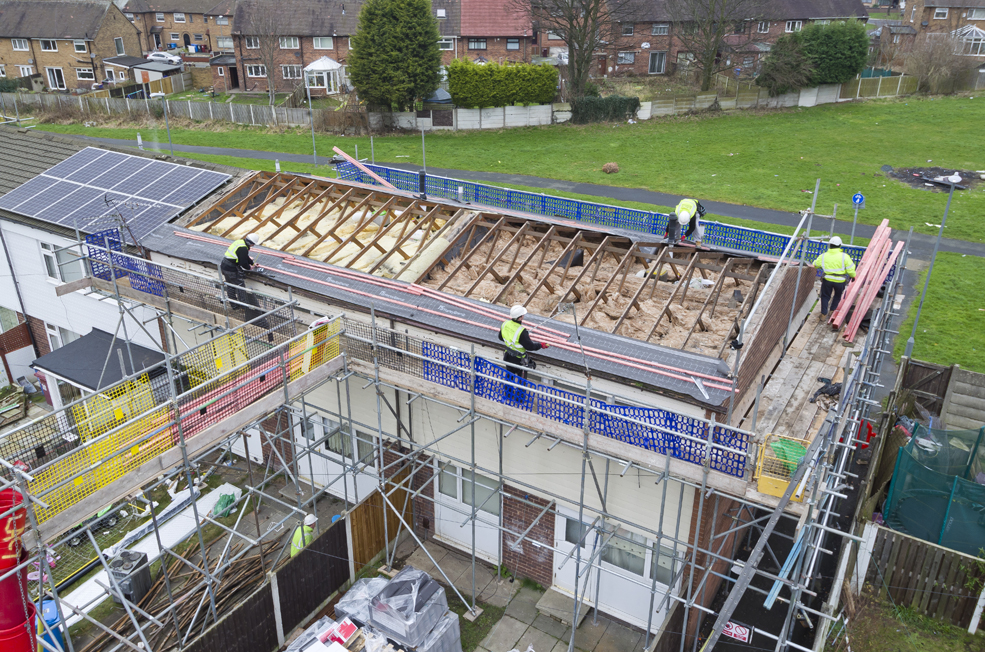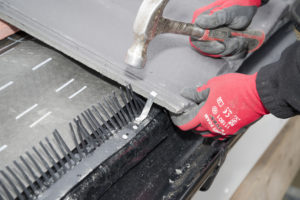
Although not yet referred to in the Building Regulations, could more stringent roof fixing standards be beneficial for local authority property managers and housing associations? Asks Gavin White, Technical Product Manager at Marley Eternit.
Over the past few years, we have undoubtedly experienced more extreme weather, creating some of the most challenging conditions for roofs across the UK. As a result, BS 5534, the Code of Practice for Slating and Tiling, was revised to make pitched roofs more secure in the face of increasingly volatile weather, whilst bringing us into line with the Eurocodes. (Pictured above is Lacy Roofing working on properties for Knowsley Housing Trust.)
The new Standard came into force in 2015 and introduced some important changes that have a significant impact on how a roof is fixed. Much has been written about the subject over the past couple of years but, to summarise, there are four key measures that everyone connected with building work should be aware of:
Fixing specifications
Under the revised Standard, changes to wind load calculations require all single lap tiles to be mechanically fixed with either a clip or a nail. The proportion of each will depend on a number of factors, depending on location, exposure, building type and roof pitch. Therefore a new fixing specification should be obtained for every project.
Mortar bedding
The use of mortar as a sole means of fixing roof tiles and fittings is now deemed insufficient. Roof tiles or fittings bedded with mortar must also be accompanied by a mechanical fix, or a full dry fix system should be used.
Underlays
Lightweight roof underlays now have a new set of requirements to ensure they are secured sufficiently, with the purpose of preventing the occurrence of ‘ballooning’, caused by wind deflection. This can, in some circumstances, place a load on the underside of the roof covering, causing it to dislodge and come off.
 Battens
Battens
It is no longer accepted practice to grade wooden battens on site and only those that have been pre, or factory, graded to the BS 5534 standard can be called roofing battens. The Health and Safety Executive states that only pre-graded 25 by 50 battens that meet BS 5534 can be used as a foothold.
Whilst these changes have a considerable impact on the security of the structure of the roof, BS 5534 is not included in the Building Regulations, even though it is widely acknowledged as best practice. This means that, as it stands, a roof could meet Building Regulations requirements but be significantly under specified by modern standards, including the possibility of being insufficiently fixed.
In fact, it is such a critical issue that the National Federation of Roofing Contractors (NFRC) is leading a cross industry group of stakeholders to lobby Government to get BS 5534 included into the Building Regulations. This is something Marley Eternit is supporting fully, alongside the other members of the Roof Tile Association.
Kevin Taylor, head of technical services, from the NFRC is leading the campaign and says: “Because BS 5534 is not specifically included in the Building Regulations, this can cause challenges when it comes to both quality control and enforcement, so we would urge people responsible for commissioning and contracting to be proactive in the specification of work and materials. Currently only BS8000-6:1990 is referenced in Regulation 7 and Approved Document Part C. This means that the only reference to roofing within the approved documents is effectively 27 years out of date and naturally much has changed in relation to workmanship since then, so it is vital this is updated.
“In addition, BS 5534:2014 sets out some important changes to the safe and secure fixing of roofs and we are working alongside our partners to strongly recommend it is included in Approved Document A. Until that time, we will be continuing to raise awareness of the importance of fitting to BS 5534. Both the NFRC and Competent Roofer believe that unless roofs are fixed properly, then this constitutes a real risk of roof failure or possibly even injury to people and damage to property, especially in high winds.
“Local authorities can be reassured that members of the NFRC and of the Competent Roofer Scheme are required to fix to the latest BS 5534 stipulations but, the same can’t be said of all roofers or general builders. We estimate that as much as 80% of roofing in the UK isn’t being done to the British Standard. So if work is not being carried out by one of our accredited installers, we would consider it best practice for local authorities to check roof fixing specifications to make sure they are compliant with the Standard.”
 Building control
Building control
So, while there is work underway to try and give more power to enforce the use of BS 5534, what are building control bodies doing in the mean time?
Phil Hammond, managing director of Local Authority Building Control (LABC), gives the following advice: “We fully support the NFRC and its partners in the bid to improve the quality of roofing and workmanship in the UK. We are working with the Building Control Alliance and encouraging all building control surveyors to follow the best practice guidelines of BS 5534:2014 and we have technical guidance and brochures available to support them in doing this. Unfortunately, at the moment, BS 5534 is not referenced in the Approved Documents, so we have to devote extra time and resources to build awareness and explain the improvements. We support industry and the NFRC in their campaign for this to be clarified in the Approved Documents.”
Indeed there are many quality and safety benefits of fixing to BS 5534. These include:
- Improved roof security and durability — protecting building stock against high winds and storms now will help to reduce repair and maintenance costs in the long-term.
- Protecting homeowners and residents by ensuring the roof is safe and fixed to modern high standards.
- Reducing re-work costs — if work is not carried out to BS 5534 and the work is challenged, it will invariably need to be put right. This is this is the responsibility ‘of the person carrying out the work.’
- Improving safety on site — reducing the risk of accidents from inferior roofing battens being used as a foothold.
Clearly there are already many local authority property managers and housing associations that have realised the benefits of fitting to BS 5534: 2014 and we would encourage others to do the same, as there is a possibility the Standard could become a mandatory requirement for building control in the near future.








